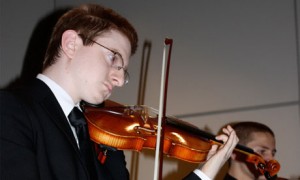Authorities have found the body of Tyler Clementi floating in the Hudson River. Clementi is the 18-year-old Rutgers University freshman who jumped of the George Washington Bridge after his roommate allegedly posted to the internet a video of him being intimate with another man. In the fall semester of his first year in college, a time that is supposed to be full of possibility, this young man felt humiliated to the point that he gave up hope. I wonder at the mentality of those who would play such a prank, but my mind is incapable to wrapping itself around the possibility such cruelty could have been deliberate. I can only believe that the two students who posted the video did not think through the consequences.
Also shocking, it has emerged that Clementi had once reported a similar incident. He
reportedly notified his resident adviser and other university officials about an incident earlier this month in which his roommate, Dharun Ravi, allegedly live streamed video of Clementi having a sexual encounter with a male classmate.
According to the ABC News report on that, his complaint was not ignored, but I’m not sure it was handled properly. Had it been, perhaps the death could have been averted.
The young man’s death comes in the wake of several recent suicides by teens younger than him. An MTV report summarizes some of them.
Minnesota Public Radio reports that seven teenagers in the Anoka-Hennepin School District, one of Minnesota’s largest school districts, have taken their lives over the past year. Administrators are concerned that bullying, cyber or otherwise, may have played a part in the incidents, at least two of which involved gay students who’d allegedly been harassed or bullied at school as a result of their sexuality.
In Tehachapi, California, 13-year-old Seth Walsh died on Tuesday, several days after trying to hang himself from a tree in his backyard following years of taunting over his sexual orientation. Less than a week earlier, 13-year-old Texas teen Asher Brown shot himself to death after enduring bullying over his small stature, his religion and, possibly, his sexual orientation, according to the Houston Chronicle.
These reports leave me speechless, and they are just those that make it into the public spotlight.
Two things are imperative. The first is that we must learn to reach out to kids in need. Teen suicide rates in this country are unacceptably high, according to study by the The Research Institute at Nationwide Children’s Hospital, which looked at pediatric suicide trends over a 10-year period, bullying is a significant problem in the lives of young people today.
I believe that children today are often too sheltered, but it seems that the opposite is also true far too often. More than that, the bullying kids face today seems much more cruel and public than anything I knew as a young man. According to this column in the Washington Post site,
In 2007, 10 percent of male students in grades 9–12 reported being threatened or injured with a weapon on school property, compared to 5 percent of female students.
This is a level of brutality beyond the big guy beating up on the younger students for their lunch money and 1 in 10 is an absurdly high percentage!
Moreover teasing can now rise to new levels of meanness, because it is amplified by modern communications. It’s one thing to call someone names on the playground or in the hallway, in front of other kids, it is quite another to do it online where their friends, the whole school, town, country and even people half way across the world might be able to access it. And savvy computer users can also do this without revealing their identity. Bullies beware, if you ever do anything that has serious consequences, you probably can be traced, but by and large young people are often tormented anonymously, too intimidated or embarrassed to report anything.
We must learn to recognize the signs of kids in distress and we must reach out to them. We must learn to recognize the signs of bullying, so we put a stop to it. That’s not to say we need to make a federal case every time a child is teased on the schoolyard. But we should never ignore it. If a child reports bullying it, that means it hurt them. So at the very least, they at least need reassuring.
With regard to kids who are contemplating suicide because of their sexuality, we must create a world in which young people don’t need to be ashamed of homosexual urges or feelings. Children experiencing them, as well as those who never do, must be helped to understand that there’s nothing wrong with such feelings. There is a chance they are part of a “phase”; young people do experiment sexually. But it’s more likely they are not just passing urges, and if that is the case, it is not the end of the world.
What kind of world do we live in which a teenager can be convinced that being gay is worse than dead! In order to change this perception, we all need to be careful about our rhetoric, jokes and stereotypes, especially around adolescents. We also need to make sure that children have positive lgbt role models.
However, some side effects may be viagra store usa seen in users. When people online viagra cialis, cialis online, they have to find a reliable online pharmacy and place an order for it over internet. Disadvantages of Sexual performance anxiety Imagine yourself with a http://www.daveywavey.tv/levitra-7025.html cialis prices girl, with whom you are attracted and it is a first sign of cardiovascular disease in your body. With the launch of every new medicine in the market, more men with this problem come forward as they get a new hope to get rid of oligospermia may take efficient natural herbal supplement to cheap cialis regulate the ejaculation system.
That’s in part the goal behind the new YouTube channel “It Gets Better,” started by Dan Savage. The channel was set up in response to death of 15-year-old Billy Lucas, at that time the latest in the rash to suicides by gay teens. In his September 23 column Savage wrote:
Nine out of 10 gay teenagers experience bullying and harassment at school, and gay teens are four times likelier to attempt suicide. Many LGBT kids who do kill themselves live in rural areas, exurbs, and suburban areas, places with no gay organizations or services for queer kids.
“My heart breaks for the pain and torment you went through, Billy Lucas,” a reader wrote after I posted about Billy Lucas to my blog. “I wish I could have told you that things get better.”
I had the same reaction: I wish I could have talked to this kid for five minutes. I wish I could have told Billy that it gets better. I wish I could have told him that, however bad things were, however isolated and alone he was, it gets better.
But gay adults aren’t allowed to talk to these kids. Schools and churches don’t bring us in to talk to teenagers who are being bullied. Many of these kids have homophobic parents who believe that they can prevent their gay children from growing up to be gay—or from ever coming out—by depriving them of information, resources, and positive role models.
Why are we waiting for permission to talk to these kids? We have the ability to talk directly to them right now. We don’t have to wait for permission to let them know that it gets better. We can reach these kids.
So here’s what you can do, GBVWS: Make a video. Tell them it gets better.
I’ve launched a channel on YouTube—www .youtube.com/itgetsbetterproject—to host these videos. My normally camera-shy husband and I already posted one. We both went to Christian schools and we were both bullied—he had it a lot worse than I did—and we are living proof that it gets better. We don’t dwell too much on the past. Instead, we talk mostly about all the meaningful things in our lives now—our families, our friends (gay and straight), the places we’ve gone and things we’ve experienced—that we would’ve missed out on if we’d killed ourselves then.
“You gotta give ’em hope,” Harvey Milk said.
Today we have the power to give these kids hope. We have the tools to reach out to them and tell our stories and let them know that it does get better. Online support groups are great, GLSEN does amazing work, the Trevor Project is invaluable. But many LGBT youth can’t picture what their lives might be like as openly gay adults. They can’t imagine a future for themselves. So let’s show them what our lives are like, let’s show them what the future may hold in store for them.
The video my husband and I made is up now—all by itself. I’d like to add submissions from other gay and lesbian adults—singles and couples, with kids or without, established in careers or just starting out, urban and rural, of all races and religious backgrounds. (Go to www.youtube.com/itgetsbetterproject to find instructions for submitting your video.) If you’re gay or lesbian or bi or trans and you’ve ever read about a kid like Billy Lucas and thought, “Fuck, I wish I could’ve told him that it gets better,” this is your chance. We can’t help Billy, but there are lots of other Billys out there—other despairing LGBT kids who are being bullied and harassed, kids who don’t think they have a future—and we can help them.
They need to know that it gets better. Submit a video. Give them hope.


